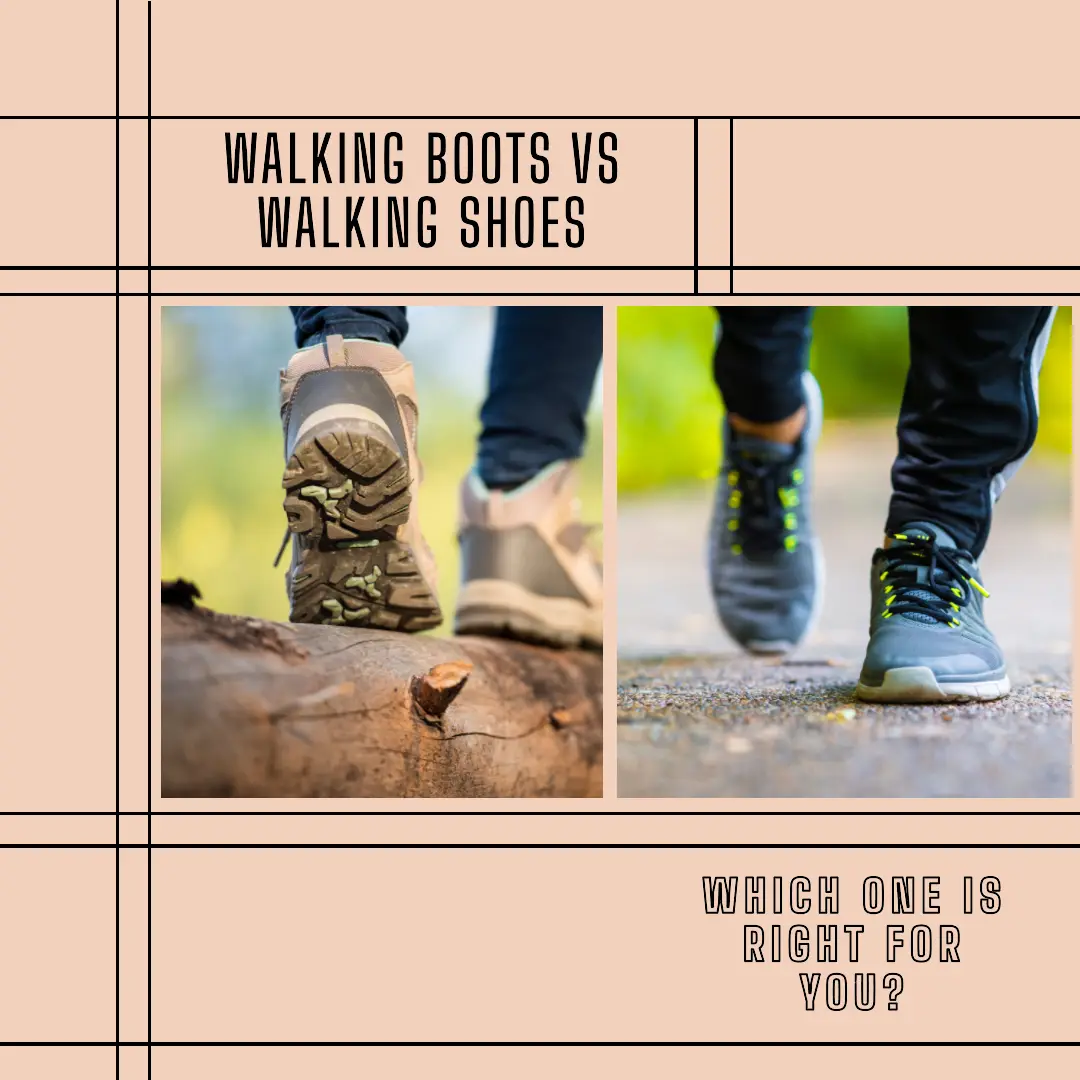Table of Contents
Some links on posts are affiliate links and will earn us a commission from qualifying purchases
When it comes to outdoor activities like walking, choosing the right footwear is crucial to your comfort and safety. The main difference between walking boots and walking shoes is that walking boots are sturdier and often have a thicker sole and higher collar, while walking shoes are generally lighter and may not always have the same technical features as boots. But which one is right for you? In this article, we will explore the differences between walking boots and walking shoes to help you make the best decision for your needs.
What type of walking are you doing?
The type of walking, whether it’s a leisurely stroll or an adventurous hike, plays a crucial role in selecting the suitable footwear. In challenging terrain like steep inclines or rocky and uneven paths, walking boots offer a more secure grip and greater ankle support against slips, twists, and sprains. Additionally, they are waterproof so that you can hike without worrying about wet feet.
Alternatively, walking shoes are an excellent choice when you plan to take well-trodden footpaths or low-level routes, where the terrain is more even and gentle on the feet. Not only are they more comfortable to wear, but they also allow you to walk for extended periods without experiencing discomfort.
Long-distance walking
Both walking boots and shoes have their merits when it comes to long-distance walking, yet which one you prefer depends on the nature of your walk and the kind of terrain. For hilly areas and treacherous, uneven terrain, walking boots offer enhanced ankle support and grip, since it’s more challenging to maintain balance in such circumstances.
Walking shoes, on the other hand, are the perfect choice for even terrain and lengthy expeditions, as they are lighter in weight and offer greater comfort. Ultimately, choosing the right footwear can make the difference between a comfortable and a difficult walk.
Choose boots if on hilly or rough terrain, shoes if on the flat.
Hiking
If you’re planning a hike, it’s crucial to ensure that your feet receive the support and preparation they deserve for the long walk ahead. Hiking trails can prove to be quite challenging, with rocky terrains that can be incredibly demanding on the feet. So, investing in a reliable pair of walking boots can provide you with the support and protection your ankles and feet require for a comfortable and safer hiking experience. A good pair of walking boots is a small investment that could make a world of difference to your overall hiking experience.
Choose boots for hiking.
Short daily walks
For walks that are shorter and less strenuous, walking shoes are a great choice. They offer more flexibility and comfort compared to walking boots, which can be more restrictive. These less-challenging walks don’t require as much protection and support as their more demanding counterparts. Wearing an appropriate set of walking shoes can help alleviate stress on the feet and improve the overall experience of a relaxed, leisurely stroll.
Choose shoes for short daily walks.
What are the weather conditions?
Weather conditions are an essential factor to consider when choosing between walking boots and walking shoes. Before setting off on a hike or long-distance walk, it’s wise to check the weather forecast to make an informed decision about your footwear.
Walking boots can provide various features that walking shoes do not, which can help you against the various weather conditions, even if you’re experiencing more than one weather front during your walk.
For instance, if there has been a recent downpour or you are walking on damp ground, walking boots with waterproof lining and reinforced soles will keep your feet dry and provide better grip, making them the safer option.
On the other hand, if you are walking on a hot summer day, walking shoes would be the better option. They are lighter and more breathable, keeping your feet cool and comfortable.
What is the difference between hiking boots and hiking shoes?
Hiking boots and shoes both serve the purpose of supporting outdoor activities, but differ in more ways than one. Boots generally have a higher height, which extends past the ankle to provide greater stability and support on rough, uneven terrain. Their sturdy construction safeguards the user from twists and turns that cause injuries, giving hikers peace of mind as they explore.
When selecting hiking boots, look for features such as:
- Ankle support: Look for hiking boots that offer good ankle support, especially if you’re hiking on uneven or rocky terrain.
- Waterproofing: Choose hiking boots with waterproof membranes or treatments to keep your feet dry in wet conditions.
- Traction: Look for hiking boots with deep lugs and sturdy soles for better grip on slippery or uneven terrain.
- Durability: Choose hiking boots made of durable materials, such as leather or synthetic fabrics, that can withstand wear and tear.
- Comfort: Look for hiking boots with cushioned insoles, breathable materials, and a comfortable fit.
Hiking shoes, on the other hand, are lightweight and flexible, focusing on comfort and breathability rather than rigid support. They are perfect for short hikes in warmer weather, where the terrain isn’t too treacherous. The lack of height may not provide the same level of ankle support as boots but gives more freedom and easier movement of the feet.
When selecting hiking shoes, look for features such as:
- Breathability: Choose hiking shoes made of breathable materials, such as mesh, to keep your feet cool and dry.
- Flexibility: Look for hiking shoes with flexible soles that allow for natural foot movement.
- Traction: Choose hiking shoes with grippy soles that can provide traction on a variety of surfaces.
- Protection: Look for hiking shoes with toe caps or reinforced uppers to protect your feet from rocks and other hazards.
- Comfort: Choose hiking shoes with a comfortable fit and good support for your arches and heels.
Are hiking boots more durable than hiking shoes?
The durability of hiking boots and hiking shoes differs based on the manufacturing materials employed. While hiking boots and hiking shoes are both crafted to last, hiking boots boast thicker and sturdier materials than hiking shoes, which may make them a more durable option.
However, the trade-off for this level of durability is that hiking boots can sometimes be heavier and less comfortable than hiking shoes while on the trail. Therefore, selecting between hiking shoes and boots based on the kind of terrain you will be hiking and your personal preference is crucial.
Maintenance and care of your hiking footwear:
To ensure the longevity and performance of your hiking footwear, it’s important to maintain and care for them properly. Some tips include:
- Cleaning and drying: After each hike, clean your hiking footwear with a soft brush and mild soap, and let them air dry in a well-ventilated area.
- Waterproofing: Reapply waterproofing treatments as needed to keep your hiking boots or shoes water-resistant.
- Storage: Store your hiking footwear in a cool, dry place away from direct sunlight, and avoid storing them in damp or humid areas.
Choosing the right boot or shoe for protection
When it comes to protection, walking boots are the better choice. They provide better ankle support and are sturdier, making them more suitable for challenging terrain. Walking shoes, on the other hand, are lighter and more comfortable, but they don’t provide the same level of protection as walking boots.
How long will you be walking for? The length of your walk is also a crucial factor to consider when choosing between walking boots and walking shoes. If you plan to walk for a long time, walking shoes would be the better option. They are lighter and more comfortable, making them suitable for lengthy walks.
However, if you plan to walk for a shorter period, walking boots would be the better choice. They provide more protection and support, making them safer and more comfortable for shorter, more challenging walks.
Pros and cons for each – hiking boots v hiking shoes
| Category | Walking Boots | Walking Shoes |
|---|---|---|
| Ankle Support | PROS: Provides better ankle support, protection, and stability. CONS: May feel restrictive, and can cause discomfort on hot days. | PROS: More lightweight and flexible, which allows the foot to move more freely. CONS: Offers less ankle support and protection, which can cause discomfort over long distances or uneven terrain. |
| Traction | PROS: Typically have deeper, more aggressive treads that offer excellent traction on muddy, rocky, or uneven terrain. CONS: Can be heavy and clunky to wear, and may be too much traction for flat, even surfaces. | PROS: Often have sleeker, flatter soles that may be more comfortable on even surfaces like roads or trails. CONS: May slip on muddy or rocky terrain, especially if the soles are worn down. |
| Durability | PROS: Built to withstand harsh conditions and heavy use, making them a good long-term investment. CONS: May take a while to break in, and may be overkill for short hikes or gentler terrain. | PROS: Typically made of lightweight materials that are ideal for mild to moderate hiking trails or everyday wear. CONS: May not hold up as well over time, and may need to be replaced more frequently than boots. |
| Water Resistance | PROS: Often made of waterproof materials that keep feet dry in wet, snowy, or muddy conditions. CONS: Can be hot and stuffy, especially in warm weather. | PROS: Often made of lightweight, breathable materials that allow feet to stay cool and dry. CONS: May not offer sufficient water protection on rainy or wet trails. |
| Price | PROS: Generally more expensive, but worth the investment for serious hikers who need the added protection and stability of boots. CONS: May be cost-prohibitive for those on a budget. | PROS: Often more affordable, and can be found in a wider range of prices. CONS: May not be as durable or long-lasting as boots, especially on rough or rocky terrain. |
These are just some of the benefits and drawbacks of each type of footwear. Ultimately, the choice between hiking boots or shoes comes down to individual preferences, terrain, and hiking plans.
What are the 3 best selling hiking boots on Amazon UK in 2022
Based on the search results I found, I can tell you that the top three best-selling hiking boots on Amazon UK in 2022 were:
- Merrell Men’s Moab 2 Vent Walking Shoe
- Merrell Men’s Moab 2 GTX Walking Shoe
- Skechers Men’s Summits Trainers
Conclusion – Walking boots v walking shoes
Ultimately, the type of footwear you choose for your outdoor excursions will depend on the level of comfort, safety and convenience that you want. Walking boots are usually preferred by experienced hikers as they offer superior ankle support and can better handle rough terrain than walking shoes.
When deciding which type of shoe is best for you, take into consideration whether you need extra protection for your ankles and feet or if a more lightweight design is more suitable for the activity planned. With so many different types of walking shoes available, it’s important to find one that offers the right combination of support, cushioning and durability so that you can enjoy all of your outdoor adventures with confidence.
Recent Posts
When you first start to walk as a hobby or means of improving your fitness, you will obviously need a pair of walking shoes or boots. But which are better, leather walking boots or boots made from...
Choosing The Best Shoes And Boots For Walking - a complete guide
Before buying your next pair of walking shoes or boots check out this guide which will answer the questions you may have


